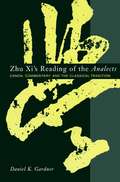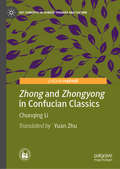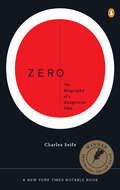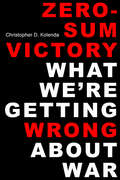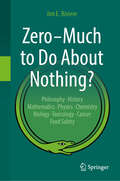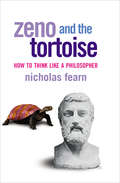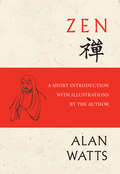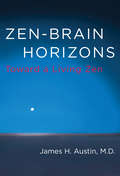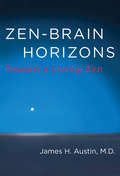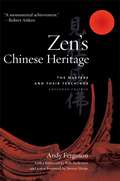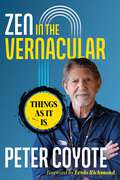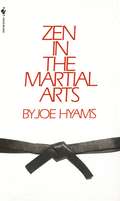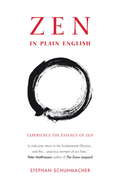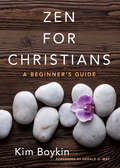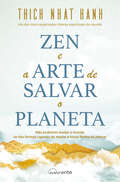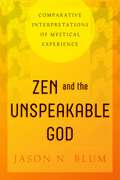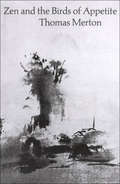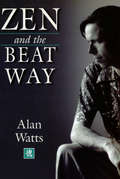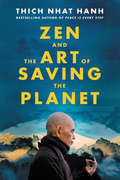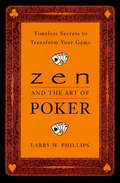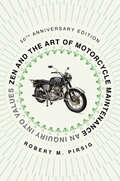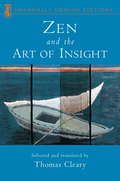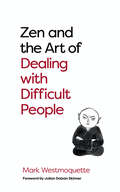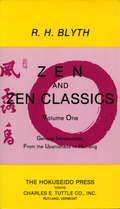- Table View
- List View
Zhu Xi's Reading of the Analects: Canon, Commentary, and the Classical Tradition
by Daniel GardnerThe Analects is a compendium of the sayings of Confucius (551–479 b.c.e.), transcribed and passed down by his disciples. How it came to be transformed by Zhu Xi (1130–1200) into one of the most philosophically significant texts in the Confucian tradition is the subject of this book.Scholarly attention in China had long been devoted to the Analects. By the time of Zhu Xi, a rich history of commentary had grown up around it. But Zhu, claiming that the Analects was one of the authoritative texts in the canon and should be read before all others, gave it a still more privileged status in the tradition. He spent decades preparing an extended interlinear commentary on it. Sustained by a newer, more elaborate language of metaphysics, Zhu's commentary on the Analects marked a significant shift in the philosophical orientation of Confucianism—a shift that redefined the Confucian tradition for the next eight centuries, not only in China, but in Japan and Korea well.Gardner's translations and analysis of Zhu Xi's commentary on the Analects show one of China's great thinkers in an interesting and complex act of philosophical negotiation. Through an interlinear, line-by-line "dialogue" with Confucius, Zhu effected a reconciliation of the teachings of the Master, commentary by later exegetes, and contemporary philosophical concerns of Song-dynasty scholars. By comparing Zhu's reading of the Analects with the earlier standard reading by He Yan (190–249), Gardner illuminates what is dramatically new in Zhu Xi's interpretation of the Analects.A pioneering study of Zhu Xi's reading of the Analects, this book demonstrates how commentary is both informed by a text and informs future readings, and highlights the importance of interlinear commentary as a genre in Chinese philosophy.
Zhong and Zhongyong in Confucian Classics (Key Concepts in Chinese Thought and Culture)
by Chunqing LiThis Key Concept pivot explores the trajectory of the semantic generation and evolution of two core concepts of ancient Chinese Confucianism, ‘Zhong’ (middle) and ‘Zhongyong’ (golden mean). In the pre-Qin period, Confucius advocated ‘middle line’ and ‘golden mean’ as the highest standards for gentlemanly behaviour and culture. In The Doctrine of the Mean the Confucian classic of the late Warring States Period, ‘middle’ obtained the ontological meaning of ‘great fundamental virtues of the world’, due to the influence of Taoism and Yinyang School. It became not only the norm of human behaviours, but also the law governing the operation of heaven and earth. Since then, idealist Confucian scholars of the Song and Ming dynasties have developed the meaning of ‘middle’ from the perspective of the relationships between heaven and man, a fundamental norm of Confucian ethics.
Zero: The Biography of a Dangerous Idea
by Charles SeifeThe Babylonians invented it, the Greeks banned it, the Hindus worshiped it, and the Church used it to fend off heretics. Now it threatens the foundations of modern physics. For centuries the power of zero savored of the demonic; once harnessed, it became the most important tool in mathematics. For zero, infinity's twin, is not like other numbers. It is both nothing and everything. In Zero, Science Journalist Charles Seife follows this innocent-looking number from its birth as an Eastern philosophical concept to its struggle for acceptance in Europe, its rise and transcendence in the West, and its ever-present threat to modern physics. Here are the legendary thinkers—from Pythagoras to Newton to Heisenberg, from the Kabalists to today's astrophysicists—who have tried to understand it and whose clashes shook the foundations of philosophy, science, mathematics, and religion. Zero has pitted East against West and faith against reason, and its intransigence persists in the dark core of a black hole and the brilliant flash of the Big Bang. Today, zero lies at the heart of one of the biggest scientific controversies of all time: the quest for a theory of everything. .
Zero-Sum Victory: What We're Getting Wrong About War
by Christopher D. KolendaThe military expert and author of Leadership presents &“the most thoughtful analysis yet of America&’s recent conflicts—and future challenges&” (Gen. Stanley A. McChrystal). Why have the major post-9/11 US military interventions turned into quagmires? Despite huge power imbalances in America&’s favor, capacity-building efforts, and tactical victories, the wars in Afghanistan and Iraq turned intractable. The US government&’s fixation on zero-sum, decisive victory in these conflicts is a key reason why these operations failed to achieve favorable and durable outcomes. In Zero-Sum Victory, retired US Army colonel Christopher D. Kolenda identifies three interrelated problems that have emerged from the government&’s insistence on zero-sum victory. First, the US government has no way to measure successful outcomes other than a decisive military victory, and thus, selects strategies that overestimate the possibility of such an outcome. Second, the United States is slow to recognize, modify, or abandon losing strategies. Third, once the United States decides to withdraw, bargaining asymmetries and disconnects in strategy undermine the prospects for a successful transition or negotiated outcome. Relying on historic examples and personal experience, Kolenda draws thought-provoking and actionable conclusions about the utility of American military power in the contemporary world—insights that serve as a starting point for future scholarship as well as for important national security reforms.
Zero – Much to Do About Nothing?
by Jim E. RiviereZero – Much to Do About Nothing? is a thought-provoking work that delves into the complexities of defining “zero” in various fields, from mathematics and physics to pharmacology and food safety. Drawing on his extensive experience in teaching, research and managing a USDA-supported chemical food safety program, Jim E. Riviere provides readers with practical examples and case studies that highlight the challenges of defining “zero” in different contexts across a wide range of fields. In his four decades of university teaching, doing research in pharmacology, toxicology, biomathematics and nanoscience, Dr. Riviere has repeatedly encountered the concept of “zero” and the broad parameters utilized to achieve a proper definition. "Zero” enters when discussions concern defining "nothing", "negligible", "very small", "below level of detection", "absence of effect" or "safe". This renders the term “zero” incredibly confusing to scientists, practitioners and regulators. This book explores the origin of the concept of “zero” in mathematics, physics, chemistry and statistics and how these concepts migrated to fields such as pharmacology, toxicology, cancer research and food safety, as well as to the legal profession in the form of regulatory science and policy. Specific chapters deal with the application of “zero” to these distinct fields. The main focus throughout the book is to illustrate how important context is to the definition of “zero”. This has assumed greater relevance today with the advent of nanoscience where “small” implies different physical and chemical behavior and the use of artificial Intelligence to analyze vast troves of data from the web. The goal of the book is to provide much-needed clarity about "zero" and break down the many issues preventing it. Riviere expertly explains how the concept of “zero” is essential to a wide range of issues, from defining negligible amounts of a substance to determining the safety of a product or process. He shows how the term “zero” can have different meanings in different fields and how this can lead to confusion and misunderstandings among scientists, practitioners and regulators. Whether you're working in Food Safety, Chemistry, Pharmacology, Mathematics, Physics or beyond, Zero – Much to Do About Nothing? is a relatable book that will deepen your understanding of the concept of “zero” and its diverse applications.
Zeno and the Tortoise: How to Think Like a Philosopher
by Nicholas FearnFor those who don't know the difference between Lucretius's spear and Hume's fork, Zeno and the Tortoise explains not just who each philosopher was and what he thought, but exactly how he came to think in the way he did. Nicholas Fearn presents philosophy as a collection of tools — the tricks of a trade that, in the end, might just be all tricks, each to be fruitfully applied to a variety of everyday predicaments. In a witty and engaging style that incorporates everything from Sting to cell phones to Bill Gates, Fearn demystifies the ways of thought that have shaped and inspired humanity — among many others, the Socratic method, Descartes's use of doubt, Bentham's theory of utilitarianism, Rousseau's social contract, and, of course, the concept of common sense. Along the way, there are fascinating biographical snippets about the philosophers themselves: the story of Thales falling down a well while studying the stars, and of Socrates being told by a face-reader that his was the face of a monster who was capable of any crime. Written in twenty-five short chapters, each readable during the journey to work, Zeno and the Tortoise is the ideal course in intellectual self-defense. Acute, often irreverent, but always authoritative, this is a unique introduction to the ideas that have shaped us all. "Entertaining and witty. A smooth, sweet concoction that should tickle the taste buds of the most philosophobic readers." — Julian Boggini, The Times Educational Supplement (U.K.) "A concise and entertaining attempt to place the skills of philosophy at our fingertips." — Olivier Burckhardt, The Independent on Sunday (U.K.)
Zen: A Short Introduction with Illustrations by the Author (Pelican Bks.)
by Alan WattsAccording to Alan Watts, &“Zen taste deplores the cluttering of a picture or of a room with many objects.&” In that sense, this minimalist book embodies the aesthetic of Zen itself. As with brushstrokes in a Japanese ink painting, the words have been used sparingly and arranged precisely, with no unnecessary detail. In seven brief chapters, Watts captures the essence of Zen Buddhism as a religion and a way of life. He explains fundamental Zen concepts, introduces revered Zen thinkers, places Zen within the broader context of Eastern religion, and traces the influence of Zen in the arts. Illustrated with calligraphy and drawings by the author, this reprint of an old classic will delight fans of Alan Watts, while introducing new readers to a legendary author who infused groundbreaking scholarship with literary brilliance.
Zen-Brain Horizons: Toward a Living Zen (The\mit Press Ser.)
by James H. AustinA neurologist and Zen practitioner clarifies the benefits of meditative training, drawing on classical Buddhist literature and modern brain research.In Zen-Brain Horizons, James Austin draws on his decades of experience as a neurologist and Zen practitioner to clarify the benefits of meditative training. Austin integrates classical Buddhist literature with modern brain research, exploring the horizons of a living, neural Zen. When viewed in the light of today, the timeless wisdom of some Zen masters seems almost to have anticipated recent research in the neurosciences. The keen attentiveness and awareness that we cultivate during meditative practices becomes the leading edge of our subsequent mental processing. Austin explains how our covert, involuntary functions can make crucial contributions to the subtle ways we learn, intuit, and engage in creative activities. He demonstrates why living Zen means much more than sitting quietly indoors on a cushion, and provides simplified advice that helps guide readers to the most important points.
Zen-Brain Horizons: Toward a Living Zen (The MIT Press)
by James H. AustinIn Zen-Brain Horizons, James Austin draws on his decades of experience as a neurologist and Zen practitioner to clarify the benefits of meditative training. Austin integrates classical Buddhist literature with modern brain research, exploring the horizons of a living, neural Zen. When viewed in the light of today, the timeless wisdom of some Zen masters seems almost to have anticipated recent research in the neurosciences. The keen attentiveness and awareness that we cultivate during meditative practices becomes the leading edge of our subsequent mental processing. Austin explains how our covert, involuntary functions can make crucial contributions to the subtle ways we learn, intuit, and engage in creative activities. Austin begins by looking back at ancient Buddhist narratives. He then weaves together the major themes of self, attention, emotion, language, and insight. He goes on to examine Zen and psychology as cultural developments, including recent information about how a clear, calm awareness can change the meditating brain. He considers the pathways through which intuitions develop on their way to becoming realized, exploring the phenomena of the spontaneous color imagery that arises during meditation. Looking out even further into the future, Austin discusses the universal themes of creativity, happiness, openness, and selflessness. Along the way, he bows in homage to William James, explores "Buddhist Botany" and "Avian Zen," demonstrates why living Zen means much more than sitting quietly indoors on a cushion, and provides simplified advice that helps guide readers to the most important points.
Zen's Chinese Heritage
by Tenshin Reb Anderson Steven Heine Andy FergusonZen's Chinese Heritage traces twenty-five generations of inlightened Buddhist teachers, supplementing their core teachings with history, biography, and poetry. The result is an intimate and profound human portrait of the enlightened Zen ancients, and an unprecedented look into the depths of the rich cultural heritage. In this new edition with even more valuable material, Ferguson surveys generations of Zen masters, moving chronologically through successive generations of ancestral teachers, supplementing their core teachings with history, biography, and starkly beautiful poetry. In addition to giving the reader the engaging sense of the "family history" of Zen, this uniquely valuable book paints a clear picture of the tradition's evolution as a religious, literary, and historical force.
Zen in the Vernacular: Things As It Is
by Peter Coyote• Shows how Zen offers a creative problem-solving mechanism and moral guide ideal for the stresses and problems of daily life• Shares the author&’s secular, vernacular interpretations of the Four Noble Truths, the Three Treasures, the Eightfold Path, and other fundamental Buddhist ideasDuring the nearly 3,000 years since the Buddha lived, his teachings have spread widely around the globe. In each culture where Buddhism was introduced, the Buddha&’s teachings have been pruned and modified to harmonize with local customs, laws, and cultures. We can refer to these modifications as &“gift wrapping,&” translating the gifts of Buddha&’s teachings in ways sensible to particular cultures in particular times. This gift-wrapping explains why Indian, Tibetan, Vietnamese, Japanese, Chinese, and Indonesian Buddhism have significant differences.In this engaging guide to Zen Buddhism, award-winning actor, narrator, and Zen Buddhist priest Peter Coyote helps us peer beneath the Japanese gift-wrapping of Zen teachings to reveal the fundamental teachings of the Buddha and show how they can be applied to contemporary daily life. The author explains that the majority of Western Buddhists are secular and many don&’t meditate, wear robes, shave their heads, or believe in reincarnation. He reminds us that the mental/physical states achieved by Buddhist practice are universal human states, ones we may already be familiar with but perhaps never considered as possessing spiritual dimensions.Exploring Buddha&’s core teachings, the author shares his own secular and accessible interpretations of the Four Noble Truths, the Three Treasures, and the Eightfold Path within the context of his lineage and the teachings of his teacher and the teachers before him. He looks at Buddha&’s teachings on our singular reality that appears as a multiplicity of things and on the &“self&” that perceives reality, translating powerful spiritual experience into the vernacular of modern life.Revealing the practical usefulness of Buddhist philosophy and practice, Zen in the Vernacular shows how Zen offers a creative problem-solving mechanism and moral guide ideal for the stresses and problems of everyday life.
Zen in the Martial Arts
by Joe Hyams"A man who has attained mastery of an art reveals it in his every action. "--Samurai Maximum. Under the guidance of such celebrated masters as Ed Parker and the immortal Bruce Lee, Joe Hyams vividly recounts his more than 25 years of experience in the martial arts. In his illuminating story, Hyams reveals to you how the daily application of Zen principles not only developed his physical expertise but gave him the mental discipline to control his personal problems-self-image, work pressure, competition. Indeed, mastering the spiritual goals in martial arts can dramatically alter the quality of your life-enriching your relationships with people, as well as helping you make use of all your abilities.
Zen in Plain English
by Stephan SchuhmacherNo other book quite engages the reader in the kinds of perceptions and experiences that the seeker will have while following this path. The Zen masters are famous for their unorthodox ways of teaching the wisdom of the 'thing itself'. Their Koans - paradoxical stories, and questions - are designed to rid the mind of over-sophisticated responses. A selection of tales from the great Zen teachers, this book coaxes the reader into a direct encounter with the life-changing perceptions of the Zen mind. Challenging us to find 'a solution that resolves and dissolves the knots in heart and mind, the chronic cramp that prevents us from breathing freely, from giving ourselves without reserve to life in all its delightful and painful facets, and from being at peace with life and with death.' In this process we are confronted by the limits of rational meaning - and we begin to understand why Zen masters use humour and paradox to lead us to the very edge of the precipice of reason, and why, at that critical point, we are gently pushed over.'Stephan Schumacher's innovative format and his fresh interpretations of this fine selection of stories from the great teachers are a useful introduction to Zen practice, and more importantly a welcome return to the fundamental Dharma of no-self, not-knowing, the thing- itself and the beauty and precision of this moment-by-moment precious moment of our lives.' Peter Matthiessen(Muryo Roshi)
Zen for Christians: A Beginner's Guide
by Gerald G. May Kim Boykin"Whereas other Christianity-meets-Buddhism books stress ideology and the intellect, this one emphasizes daily acts of practice." — Publishers Weekly (starred review) In this illuminating and insightful guide, Kim Boykin offers Christians a way to incorporate Zen practices into their lives without compromising their beliefs and faith.Zen for Christians assumes curiosity but no real knowledge as it walks readers through specific concepts of Zen philosophy — including suffering, attachment, and enlightenment — and explains each in a simple but lively way. Sections between chapters gently demonstrate Zen meditation practices, explaining the basics in a clear, engaging manner. Placing Buddhist and Christian teachings side by side helps readers not only understand Zen but also shows their compatibility. Drawing on Dr. Boykin's own personal search through Buddhism and Christianity as well as her background in theological studies, this thought-provoking work illustrates how Zen practice can be particularly useful for Christians who want to enrich their faith by incorporating contemplative practices."An excellent introduction to Zen — clear and to the point, practical, respectful, and even humorous at times." — Yoga Journal "Makes Zen practice more approachable and less esoteric … a straightforward guide for those who want to try Zen for themselves." — Monastic Interreligious Dialogue Bulletin "A trustworthy and delightful guide. Kim Boykin will demystify and deepen your understanding of both the traditions she practices. A gem!" — James W. Fowler, author, Stages of Faith "Kim Boykin writes in the skilled language of simplicity. While addressing those new to Zen, she offers practical wisdom, challenge, and encouragement to all practitioners." — Rose Mary Dougherty, Shalem Institute for Spiritual Formation, Bethesda, Maryland "The great religions of the world have much to learn from each other. Kim Boykin's book is a skillful step in that direction. The heart of the matter of Zen is presented in a direct and informative way that is based on her firsthand experience of Zen training. This should prove to be a helpful guidebook for any Christian who wishes to explore Zen practice." — John Daido Loori, roshi, abbot, Zen Mountain Monastery "This lovely, wise, and practical introduction to Zen keeps its promise of companionship as the kind of spiritual cookbook you can bring right into the kitchen. Recipe-reading like this, in fact, inspires you to get into the kitchen, encourages you to keep at it, and invites you to share your efforts in communion with others." — Steven Tipton, coauthor, Habits of the Heart "An excellent resource on Zen practice, written from a pragmatic, personal, and yet sophisticated point of view. What a fine contribution to Buddhist-Christian understanding!" — Judith Simmer-Brown, coauthor, Benedict's Dharma: Buddhists Comment on the Rule "This is a good-humored, intelligent, nonguilt-inducing book written by a person who shows us clearly what it would be like to reap the benefits of what she preaches." — Roberta Bondi, author, Memories of God and Houses: A Family Memoir of Grace
Zen e a Arte de Salvar o Planeta
by Thich Nhat HanhO livro mais recente de um dos mais respeitados líderes espirituais do mundo. Não podemos mudar o mundo se não formos capazes de mudar a nossa forma de pensar. Atualmente, enfrentamos uma poderosa interseção de crises: destruição ecológica, colapso climático, aumento da desigualdade, injustiça racial e os impactos duradouros de uma pandemia devastadora. Para enfrentarmos estes desafios, precisamos de encontrar formas de fortalecer a nossa lucidez, compaixão e coragem para agir. A mensagem de Thich Nhat Hanh é muito clara: existe algo que temos o poder de mudar, que fará toda a diferença, e esse algo é a nossa mente. A nossa forma de olhar e de pensar as coisas determina as ações e decisões que tomamos ou evitamos, como nos relacionamos com aqueles que amamos ou de quem discordamos, e como reagimos numa crise. O mindfulness e as visões decisivas da meditação podem ajudar-nos a criar um mundo regenerativo em que todas as vidas sejam respeitadas. Zen e a Arte de Salvar o Planeta mostra-nos uma nova forma de viver e de trazer harmonia a nós próprios, aos nossos relacionamentos e à Terra. «Precisamos de despertar juntos e, se despertarmos juntos, teremos uma hipótese. A nossa forma de viver e planear o futuro conduziu-nos a esta situação. E agora precisamos de olhar profundamente para encontrarmos uma solução, não apenas como indivíduos, mas como um coletivo, uma espécie.» — Thich Nhat Hanh «Thich Nhat Hanh mostra-nos a íntima ligação entre uma pessoa, a sua paz interior e a paz no mundo.» Dalai Lama «Pode ser difícil manter uma atitude positiva e sentir esperança. Neste livro, o monge vietnamita, professor, autor, poeta e ativista da paz, Thich Nhat Hanh, aplica a sabedoria budista à vida quotidiana, ajudando os leitores a fazerem as pazes com o seu lugar no mundo e dando-lhes as ferramentas para aceitarem as circunstâncias que fogem de seu controlo.» Booklist
Zen and the Unspeakable God: Comparative Interpretations of Mystical Experience
by Jason N. BlumZen and the Unspeakable God reevaluates how we study mystical experience. Forsaking the prescriptive epistemological box that has constrained the conversation for decades, ensuring that methodology has overshadowed subject matter, Jason Blum proposes a new interpretive approach—one that begins with a mystic’s own beliefs about the nature of mystical experience. Blum brings this approach to bear on the experiential accounts of three mystical exemplars: Meister Eckhart, Ibn al-ʿArabi, and Hui-neng. Through close readings of their texts, he uncovers the mystics’ own fundamental assumptions about transcendence and harnesses these as interpretive guides to their experiences.The predominant theory-first path to interpretation has led to the misunderstanding and misrepresentation of individual mystical experiences and fostered specious conclusions about cross-cultural comparability among them. Blum’s hermeneutic invites the scholarly community to begin thinking about mystical experience in a new way—through the mystics’ eyes. Zen and the Unspeakable God offers a sampling of the provocative results of this technique and an explanation of its implications for theories of consciousness and our contemporary understanding of the nature of mystical experience.
Zen and the Birds of Appetite
by Thomas Merton"Zen enriches no one," Thomas Merton provocatively writes in his opening statement to Zen and the Birds of Appetite--one of the last books to be published before his death in 1968. "There is no body to be found. The birds may come and circle for a while. . . but they soon go elsewhere. When they are gone, the 'nothing,' the 'no-body' that was there, suddenly appears. That is Zen. It was there all the time but the scavengers missed it, because it was not their kind of prey. " This gets at the humor, paradox, and joy that one feels in Merton's discoveries of Zen during the last years of his life, a joy very much present in this collection of essays. Exploring the relationship between Christianity and Zen, especially through his dialogue with the great Zen teacher D. T. Suzuki, the book makes an excellent introduction to a comparative study of these two traditions, as well as giving the reader a strong taste of the mature Merton. Never does one feel him losing his own faith in these pages; rather one feels that faith getting deeply clarified and affirmed. Just as the body of "Zen" cannot be found by the scavengers, so too, Merton suggests, with the eternal truth of Christ.
Zen and the Beat Way
by Alan WattsZen and the Beat Way is based upon selections from Alan Watts's early radio talks, many of which were first aired on the Pacifica Radio Network in the late fifties and early sixties, and sessions from two of his most compelling seminarsin the mid-sixties.
Zen and the Art of Saving the Planet
by Thich Nhat Hanh“When you wake up and you see that the Earth is not just the environment, the Earth is us, you touch the nature of interbeing. And at that moment you can have real communication with the Earth… We have to wake up together. And if we wake up together, then we have a chance. Our way of living our life and planning our future has led us into this situation. And now we need to look deeply to find a way out, not only as individuals, but as a collective, a species.”-- Thich Nhat HanhWe face a potent intersection of crises: ecological destruction, rising inequality, racial injustice, and the lasting impacts of a devastating pandemic. The situation is beyond urgent. To face these challenges, we need to find ways to strengthen our clarity, compassion, and courage to act.Beloved Zen Master Thich Nhat Hanh is blazingly clear: there’s one thing we all have the power to change, which can make all the difference, and that is our mind. Our way of looking, seeing, and thinking determines every choice we make, the everyday actions we take or avoid, how we relate to those we love or oppose, and how we react in a crisis.Mindfulness and the radical insights of Zen meditation can give us the strength and clarity we need to help create a regenerative world in which all life is respected. Filled with Thich Nhat Hanh’s inspiring meditations, Zen stories and experiences from his own activism, as well as commentary from Sister True Dedication, one of his students Zen and the Art of Saving the Planet shows us a new way of seeing and living that can bring healing and harmony to ourselves, our relationships, and the Earth.
Zen and the Art of Poker: Timeless Secrets to Transform Your Game
by Larry PhillipsInside the intriguing world of poker lies a fascinating exercise in strategy and extreme concentration--many of the same principles that underpin the one-thousand-year-old philosophy of Zen spirituality. Zen and the Art of Poker is the first book to apply Zen theories to America's most popular card game, presenting tips that readers can use to enhance their game. Among the more than one hundred rules that comprise this book, readers will learn to:* Make peace with folding* Use inaction as a weapon* Make patience a central pillar of their strategy* Pick their times of confrontationUsing a concise and spare style, in the tradition of Zen practices and rituals, Zen and the Art of Poker traces a parallel track connecting the two disciplines by giving comments and inspirational examples from the ancient Zen masters to the poker masters of today.
Zen and the Art of Motorcycle Maintenance: An Inquiry Into Values (Perennial Classics Ser.)
by Robert M PirsigTHE CLASSIC BOOK THAT HAS INSPIRED MILLIONSA penetrating examination of how we live and how to live betterFew books transform a generation and then establish themselves as touchstones for the generations that follow. Zen and the Art of Motorcycle Maintenance is one such book. This modern epic of a man’s search for meaning became an instant bestseller on publication in 1974, acclaimed as one of the most exciting books in the history of American letters. It continues to inspire millions. A narration of a summer motorcycle trip undertaken by a father and his son, Zen and the Art of Motorcycle Maintenance becomes a personal and philosophical odyssey into fundamental questions on how to live. The narrator's relationship with his son leads to a powerful self-reckoning; the craft of motorcycle maintenance leads to an austerely beautiful process for reconciling science, religion, and humanism. Resonant with the confusions of existence, this classic is a touching and transcendent book of life.This new edition contains an interview with Pirsig and letters and documents detailing how this extraordinary book came to be.
Zen and the Art of Insight
by Thomas ClearyThe Prajnaparamita ("perfection of wisdom") sutras are one of the great legacies of Mahayana Buddhism, giving eloquent expression to some of that school's central concerns: the perception of shunyata, the essential emptiness of all phenomena; and the ideal of the bodhisattva, one who postpones his or her own enlightenment in order to work for the salvation of all beings. The Prajnaparamita literature consists of a number of texts composed in Buddhist India between 100 BCE and 100 CE. Originally written in Sanskrit, but surviving today mostly in their Chinese versions, the texts are concerned with the experience of profound insight that cannot be conveyed by concepts or in intellectual terms. The material remains important today in Mahayana Buddhism and Zen. Key selections from the Prajnaparamita literature are presented here, along with Thomas Cleary's illuminating commentary, as a means of demonstrating the intrinsic limitations of discursive thought, and of pointing to the profound wisdom that lies beyond it. Included are selections from: * The Scripture on Perfect Insight Awakening to Essence * The Essentials of the Great Scripture on Perfect Insight * Treatise on the Great Scripture on Perfect Insight * The Scripture on Perfect Insight for Benevolent Rulers * Key Teachings on the Great Scripture of Perfect Insight * The Questions of Suvikrantavikramin
Zen and the Art of Dealing with Difficult People
by Mark WestmoquetteThis is a unique guide to coping with challenging people using practical Zen and mindfulness tools. It helps readers explore their reactions, break free from knee-jerk response patterns and see if these people may in fact prove to be useful teachers in life – troublesome Buddhas.This is a guide to applying the teachings of mindfulness and Zen to the troublesome or challenging people in our lives. Perhaps you can see there&’s often a pattern to your behaviour in relation to them and that it often causes pain – perhaps a great deal of pain. The only way we can grow is by facing this pain, acknowledging how we feel and how we&’ve reacted, and making an intention or commitment to end this repeating pattern of suffering. In this book, Mark Westmoquette speaks from a place of profound personal experience. A Zen monk, he has endured two life-changing traumas caused by other people: his sexual abuse by his own father; and his stepfather&’s death and mother&’s very serious injury in a car crash due to the careless driving of an off-duty policeman. He stresses that by bringing awareness and kindness to these relationships, our initial stance of &“I can&’t stand this person, they need to change&” will naturally shift into something much broader and more inclusive. The book makes playful use of Zen koans – apparently nonsensical phrases or stories – to help jar us out of habitual ways of perceiving the world and nudge us toward a new perspective of wisdom and compassion.
Zen and Zen Classics volume 1: From the Upanishads to Huineng
by R. H. BlythThis is not a dry scholarly book on Zen. It is a fascinating introduction into a study of self-enlightenment and inner reason that has been a driving force of all Japanese culture. Written by Reginal Horace Blyth (1898-1964) this is a volume free of the dry pedantry that has hobbled so many well meaning French and English studies of Zen. It is free also of the breathless mystery-mongering that unfortunately has bloated American Zen.Blyth reads easily. The questions he poses; the views he offers....all lead to a sense of inner self and an awakening of an awareness of the surrounding universe and one's relationship to it.After discussing "What is Zen?" (and what isn't) Blyth sketches a history of Zen dating from 1000 B.C. to715 A.D., the year of the death of the Sixth patriarch, Huineg. With a historical background thus established, Blyth next provides translations and commentary on some of the most important and basic Zen literature in existence. For the Zen initiate then, this book is an excellent beginning. For the practitioner, further meaningful revelations await.
Zen and Zen Classics volume 1
by R. H. BlythThis is not a dry scholarly book on Zen.It is a fascinating introduction into a study of self-enlightenment and inner reason that has been a driving force of all Japanese culture. Written by Reginal Horace Blyth (1898-1964) this is a volume free of the dry pedantry that has hobbled so many well meaning French and English studies of Zen. It is free also of the breathless mystery-mongering that unfortunately has bloated American Zen.Blyth reads easily. The questions he poses; the views he offers....all lead to a sense of inner self and an awakening ofan awareness of the surrounding universe and one's relationshipto it.After discussing "What is Zen?" (and what isn't) Blyth sketches a history of Zen dating from 1000 B.C. to715A.D., the year of the death of the Sixth Patriarch, Huineg. With a historical background thus established, Blyth next providestranslations and commentary on some of the most important and basic Zen literature in existence. For the Zen initiate then, this book is an excellent beginning. For the practitioner, further meaningful revelations await.
